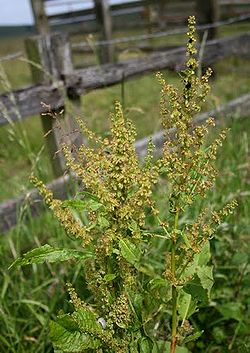Yellow Dock
Other Names : Rumex Crispus, Chin-ch’iao-mai, curled dock, curly dock, garden patience, narrow dock, parell, patience herb, sour dock.
Yellow dock is a perennial herb belonging to the Polygonaceae family, commonly referred to as the knotweed family. This family also includes rhubarb, buckwheat, and sorrel. Mature yellow dock stands no more than 4 feet tall and is reddish brown in colour. Its common name refers to the yellow taproot rather than the flowers or leaves. Its other common name, curly dock, refers to the willowy, undulating leaves. The leaves are grouped around a central point at the base of the stem. Plants produce light green floppy flowers between early spring and late autumn. The flowers are arranged in loose clumps along a stalk above the leaves. Plant Parts Used : Roots, leaves, and seeds.
Source of Anthraquinone
Special Precautions of Yellow Dock
- Don't confuse with Sheep Sorrel which taken in large amounts might increase the risk of developing kidney stones. There is also a report of death after consuming a large amount (500 grams) of sorrel.
- As with all herbal remedies, allergic reactions to yellow dock are possible. If there are signs of allergic reaction, stop treatment and seek medical advice. Yellow dock should not be taken in conjunction with medication for controlling calcium in the blood as excess use can lead to calcium deficiency in the blood. As it has diuretic effects, it should not be take with other diuretics. Nor should it be taken if there are pre-existing kidney or liver problems as it may only aggravate conditions.
- Yellow dock, like any herbal laxative, should not be taken in combination with Lasix or any other brand name furosemide used for treatment of congestive heart failure and edema as it can cause potassium depletion. In high dosage, yellow dock can cause vomiting and lead to peristalsis and acute intestinal pain and if eat in excess, even death.
- A medical practitioner should be consulted immediately if any of the following symptoms are experienced after treatment with yellow dock: intestinal pain, vomiting, nausea, confusion, fatigue, seizures, and mouth numbness
- The oxalates found in the leaves of this medicinal herb can cause kidney stones and gout if consumed in large quantities, though oxalate levels in the root are safe. Yellow dock should not be used without medical supervision if pregnant or breast-feeding and should not be given to children.
The benefits of Yellow Dock are
- It is the taproot of yellow dock that is most commonly used in herbal remedies as it is rich in many compounds known to have cleansing and calming qualities as well as minerals such as calcium, iron, magnesium and phosphorous. The root is dug up in autumn, chopped and then dehydrated for storage.
- Yellow dock contains a number of anthraquinones, including emodins, which are known for their laxative action. Though small doses of yellow dock can be used as an herbal remedy for diarrhoea, higher doses actually cause diarrhoea. The herb acts to stimulate peristalsis, and increase mucous production and secretion of water in the colon, hence alleviating the discomforts associated with constipation.
- This herb also has diuretic properties, which makes it a natural remedy for water retention, inflammation of the bladder and urinary stones.
- Both the laxative and the diuretic properties of yellow dock make this herb a natural cleanser. The toxins are flushed out of the system through the urine and stool. Yellow dock has been used to cleanse the circulatory system, liver, spleen, kidneys and bladder. It is often blended with other cleansing herbs, such as burdock, red clover, or dandelion, to flush the body of toxins and clear the path to healing the primary inflictions such as acne, boils, eczema, psoriasis and fungal infections.
- When prepared as a poultice, yellow dock has a calming effect and is used as a natural remedy for boils and burns as well as skin problems such as weeping eczema, psoriasis, nettle rash, boils and abscesses. It has even been used as an herbal remedy in the treatment of syphilis and other venereal diseases with skin outbreaks as it alleviates itching and inflammation.
- Yellow dock has been used extensively to resolve issues associated with menstruation. It is a traditional remedy for menstrual pain and heavy bleeding and has also been known to be helpful for unbalanced menstrual cycles. This herb has also been reported to increase fertility.
- The root of yellow dock is rich in iron and often used as an herbal remedy for anaemia. The laxative effect of this medicinal herb also reduces issues of constipation often associated with iron supplements.
- Yellow dock, like many other Rumex species, contains the antibacterial compound, rumicin. This makes this herb a natural remedy for treating bacterial infections of Escherichia, Salmonella, Staphylococcus, and Bacillus.
- Glycosides found in yellow dock can help stimulate the liver, which helps heal poor absorption of nutrients and increases bile production which has further detoxifying effects. This trait made yellow dock a common herbal remedy for jaundice sufferers during the 19th century.
- Yellow dock is an herbal treatment for the relief of symptoms associated with upper respiratory disorders such as emphysema, asthma, and bronchitis.
- The list of illnesses that yellow dock has been used to treat is extensive. Besides what has already been described, this medicinal herb has been used in the treatment of anthrax, anorexia, cancer, chronic fatigue syndrome, common cold, cramps, depression, fever, general weakness or loss of strength, headaches, hepatitis, high cholesterol, leprosy, malaria, menopause, mental stupor, mouth sores, oral hygiene, ring worm, and tuberculosis.
